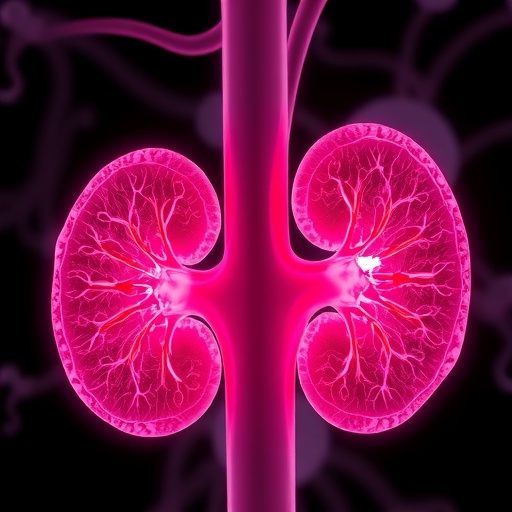In a cutting-edge study poised to redefine our understanding of cellular death mechanisms and kidney injury, researchers have unveiled the multifaceted protective roles of oestradiol against ferroptosis and acute kidney injury (AKI). This groundbreaking research confronts the complex biochemical pathways implicated in ferroptosis—a regulated, iron-dependent form of cell death governed by lipid peroxidation—and delineates how endogenous steroid hormones mitigate these destructive processes in renal tissues.
The research meticulously harnesses various human and murine cell lines, including HT1080, HT29, HeLa, and NIH-3T3, cultivating them under tightly controlled laboratory conditions to explore the influence of oestradiol and its derivatives. Employing state-of-the-art CRISPR-Cas9 gene editing, guided RNAs (gRNAs) were designed and inserted into plasmids targeting key genes implicated in ferroptotic pathways, such as CBS, CTH, AIFM2, ESR1, and FAR1. This genetic manipulation facilitated a granular analysis of the molecular players that orchestrate ferroptosis, allowing the team to modulate gene expression with remarkable precision.
Central to the investigation was the induction of ferroptosis using an array of established ferroptosis inducers (FINs), including erastin, RSL3, FIN56, and FINO2, representing the diverse classes of FINs that perturb cellular homeostasis through distinct biochemical routes. The team further examined necrotic pathways via thioredoxin reductase inhibition, expanding the scope of cell death modalities studied. Quantitative assessments of cell viability and death were conducted using flow cytometry techniques employing annexin V and 7-AAD staining, offering a high-resolution temporal and phenotypic picture of cell fate post-treatment.
Western blot analysis emerged as a crucial technique, revealing the expression dynamics of pivotal proteins such as ACSL4, GPX4, and ESR1, among others. These assays confirmed not only the efficacy of genetic knockouts but also the modulation of ferroptosis-sensitive proteins in response to hormonal treatment and gene editing. Importantly, the use of freshly isolated renal tubules from murine models enabled the extrapolation of cellular phenomena to organ-level responses, bridging the gap between in vitro and in vivo observations.
The work extended to primary renal tubule isolation from mice, pigs, and humans, adhering to stringent ethical standards and leveraging advanced enzymatic digestion protocols to preserve tubule integrity. These tubules served as a biologically relevant microsystem to test therapeutic interventions. Through lactate dehydrogenase (LDH) release assays, a sensitive marker for cellular membrane integrity and necrosis, the research delineated the extent of ferroptosis-induced damage and the protective efficacy of oestradiol and related compounds under ischemia-reperfusion injury (IRI) conditions.
Intricately designed in vivo experiments on murine models, including tamoxifen-inducible Gpx4 knockout mice and bilateral kidney IRI models, corroborated the protective effects of estradiol and its analogues. These models were subjected to precisely timed ischemic insults, with intervention arms receiving ferrostatins such as Fer-1 and UAMC-2303 or 2-hydroxyoestradiol, illuminating the therapeutic potential of these molecules in renal contexts. Ovariectomy and subsequent IRI surgeries elucidated the consequences of endogenous estrogen depletion and reaffirmed the hormone’s key role in mitigating AKI.
Sophisticated imaging and analytical techniques supplemented these interventions. Time-lapse fluorescence microscopy, utilizing SYTOX Green and mitochondrial tracers, provided real-time visualization of cellular demise within renal tubules, accentuating the sex-dependent nuances in ferroptotic vulnerability. Electron microscopy further detailed ultrastructural alterations in tubules, affirming the biochemical findings.
The study also employed cutting-edge lipidomics and mass spectrometry-based steroid hormone detection to quantify the molecular shifts induced by ferroptosis and hormonal interventions. Ultra-performance liquid chromatography coupled to tandem mass spectrometry enabled the precise measurement of sulfur-containing metabolites and oestradiol derivatives within kidney tubules. These data exposed the biochemical crosstalk between sulfur metabolism, steroid homeostasis, and ferroptotic regulation, uncovering novel molecular underpinnings of kidney resilience.
Simulated liposomal oxidation assays reinforced the mechanistic insights, demonstrating the radical-trapping antioxidant (RTA) capacities of estradiol derivatives in complex lipid environments. These assays, using egg phosphatidylcholine liposomes, unveiled the efficacy of these compounds in mitigating lipid peroxidation driven by di-tert-undecyl hyponitrite (DTUN), thereby confirming their antioxidant prowess in cell membrane mimetics.
Collectively, these multi-layered experimental approaches deliver compelling evidence positioning oestradiol as a potent modulator of ferroptosis, offering multifaceted protection against acute kidney insult. This study not only advances fundamental cell death biology but also charts new avenues for therapeutic exploration targeting steroid hormone pathways in renal disease.
Moving beyond basic science, this research holds immense translational promise. Acute kidney injury, a frequent and severe clinical complication, currently lacks effective targeted therapies. By elucidating the hormonal determinants that shield renal tissues from oxidative death pathways, this work paves the way for innovative treatments that exploit endogenous protective mechanisms. The detailed sex-specific analyses further underscore the importance of personalized medicine approaches, acknowledging the divergent vulnerabilities and treatment responses across genders.
Furthermore, the coupling of advanced gene editing with precise biochemical assays exemplifies a new era of mechanistic biology where molecular manipulations can be systematically linked to functional outcomes. The meticulous use of multiple animal models and primary human tissues reinforces the robustness and clinical relevance of these findings.
This research also invites revisiting the role of steroid hormones in other ferroptosis-related pathologies. Given that ferroptosis has been implicated in diverse conditions ranging from neurodegeneration to cancer, the regulatory role of oestradiol may transcend renal biology, necessitating broader investigations into hormonal modulation as a universal protective strategy.
In conclusion, this seminal work unravels how multiple functions of oestradiol intricately inhibit ferroptosis, thereby safeguarding renal integrity during acute injury. These insights herald a paradigm shift in understanding cell death regulation by endogenous hormones and open promising therapeutic horizons for managing AKI and likely other ferroptosis-associated diseases.
Subject of Research: Mechanisms of ferroptosis inhibition by oestradiol and its role in acute kidney injury.
Article Title: Multiple oestradiol functions inhibit ferroptosis and acute kidney injury.
Article References:
Tonnus, W., Maremonti, F., Gavali, S. et al. Multiple oestradiol functions inhibit ferroptosis and acute kidney injury. Nature (2025). https://doi.org/10.1038/s41586-025-09389-x
Image Credits: AI Generated




